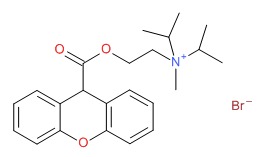NCBI Bookshelf. A service of the National Library of Medicine, National Institutes of Health.
LiverTox: Clinical and Research Information on Drug-Induced Liver Injury [Internet]. Bethesda (MD): National Institute of Diabetes and Digestive and Kidney Diseases; 2012-.

LiverTox: Clinical and Research Information on Drug-Induced Liver Injury [Internet].
Show detailsOVERVIEW
Introduction
Propantheline is an anticholinergic agent used to treat gastrointestinal conditions associated with intestinal spasm and to decrease secretions during anesthesia. Propantheline has not been implicated in causing liver enzyme elevations or clinically apparent acute liver injury.
Background
Propantheline (proe pan' the leen) is a synthetic quaternary ammonium anticholinergic agent which inhibits the muscarinic actions of acetylcholine on autonomic nerve endings, decreasing respiratory and gastrointestinal secretions and intestinal motility. Propantheline has broad activity against muscarinic acetylcholine receptors, but its highly polar quaternary ammonium group makes it less likely to cross lipid membranes such as the blood brain barrier, which is believed to decrease the potential for central nervous system effects. Propantheline has been used largely to alleviate symptoms of irritable bowel syndrome, painful gastrointestinal motility disorders and acid-peptic ulcer disease. Propantheline was approved for use in the United States in 1953 but is now not commonly used, having been replaced by more effective antiulcer agents. Propantheline is available in tablets of 7.5 and 15 mg in generic forms and under the brand name Pro-Banthine. The typically recommended oral dose in adults is 7.5 to 15 mg three times daily and 30 mg at bedtime. Common side effects are those of parasympathetic stimulation and include dryness of the mouth and eyes, decreased sweating, headache, visual blurring, constipation, and urinary retention. Because of its structure, propantheline is believed to be less likely than other anticholinergics to cross the blood brain barrier and cause central nervous system effects such as restlessness, confusion and hallucinations. Anticholinergic agents can precipitate acute narrow angle glaucoma and acute urinary retention.
Hepatotoxicity
Like other anticholinergic agents, propantheline has not been linked to episodes of liver enzyme elevations or clinically apparent liver injury. It is metabolized at least partially in the liver. A reason for its safety may relate to the low daily dose.
References on the safety and potential hepatotoxicity of anticholinergics are given together after the Overview section on Anticholinergic Agents.
Drug Class: Anticholinergic Agents
PRODUCT INFORMATION
REPRESENTATIVE TRADE NAMES
Propantheline – Generic, Pro-Banthine®
DRUG CLASS
Anticholinergic Agents
Product labeling at DailyMed, National Library of Medicine, NIH
CHEMICAL FORMULA AND STRUCTURE
| DRUG | CAS REGISTRY NUMBER | MOLECULAR FORMULA | STRUCTURE |
|---|---|---|---|
| Propantheline | 50-34-0 | C23-H30-N-O3.Br |
 |
- Review Glycopyrrolate.[LiverTox: Clinical and Researc...]Review Glycopyrrolate.. LiverTox: Clinical and Research Information on Drug-Induced Liver Injury. 2012
- Review Propantheline bromide in the management of hyperhidrosis associated with spinal cord injury.[Ann Pharmacother. 1995]Review Propantheline bromide in the management of hyperhidrosis associated with spinal cord injury.Canaday BR, Stanford RH. Ann Pharmacother. 1995 May; 29(5):489-92.
- Review Dicyclomine.[LiverTox: Clinical and Researc...]Review Dicyclomine.. LiverTox: Clinical and Research Information on Drug-Induced Liver Injury. 2012
- Review Mepenzolate.[LiverTox: Clinical and Researc...]Review Mepenzolate.. LiverTox: Clinical and Research Information on Drug-Induced Liver Injury. 2012
- Biopharmaceutic factors that influence effects of anticholinergic drugs: comparison of propantheline, hexocyclium, and isopropamide.[J Pharm Sci. 1977]Biopharmaceutic factors that influence effects of anticholinergic drugs: comparison of propantheline, hexocyclium, and isopropamide.Grundhofer B, Gibaldi M. J Pharm Sci. 1977 Oct; 66(10):1433-5.
- Propantheline - LiverToxPropantheline - LiverTox
Your browsing activity is empty.
Activity recording is turned off.
See more...